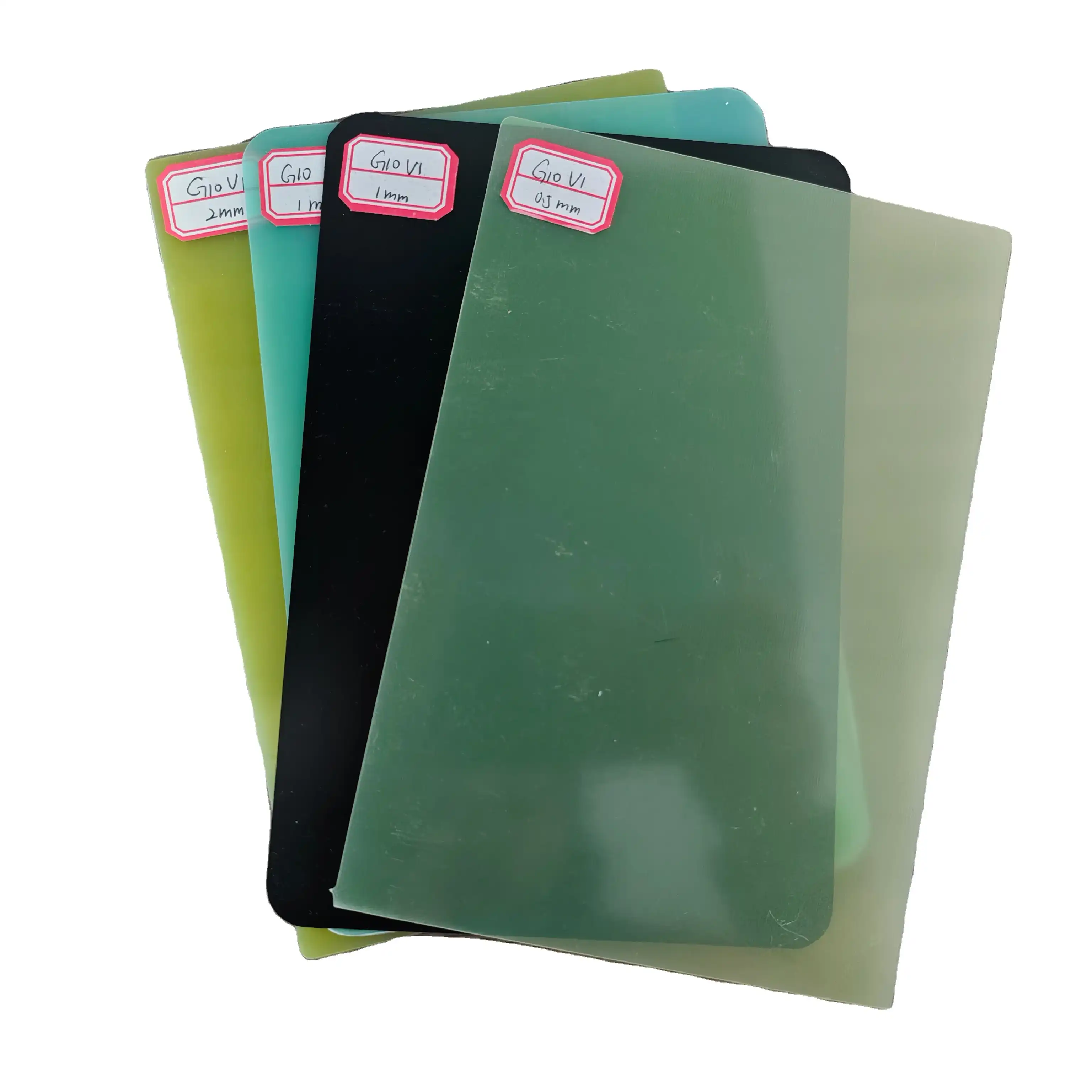How Do G10 and G11 Compare in Dielectric Strength?
Dielectric Strength Measurements
Dielectric strength, a key factor for reliable electrical insulation, differs slightly between G10 and G11 sheets. G10 typically offers a dielectric strength ranging from 800 to 900 V/mil, while G11 achieves a slightly higher range of 850 to 950 V/mil. This difference arises from variations in resin composition and curing processes between the two materials. Even this modest increase in G11's dielectric strength can enhance its ability to withstand higher voltages without breakdown, making it advantageous in demanding electrical applications.
Factors Influencing Dielectric Performance
The dielectric performance of both G10 and G11 sheets is influenced by multiple factors, including material thickness, operating temperature, humidity, and surface contamination. G11's superior thermal stability allows it to retain its dielectric properties more effectively under elevated temperatures, reducing the risk of insulation failure in high-heat environments. By contrast, G10 may experience a slight decrease in dielectric strength when exposed to the same thermal or environmental conditions, making G11 preferable for applications with demanding thermal or environmental stress.
Practical Implications in Design
In electrical component design, the small difference in dielectric strength between G10 and G11 can affect material selection decisions. For applications where consistent insulation performance under high temperatures is critical, G11's enhanced heat resistance and dielectric stability justify its higher cost. G10, however, remains an excellent choice for standard insulation tasks where thermal stress is moderate and cost efficiency is a priority. Designers must balance performance requirements, operating conditions, and budget considerations when selecting between these two materials.
Electrical Insulation and Voltage Withstand Capabilities
Comparative Insulation Properties
Both G10 and G11 sheets are recognized for their excellent electrical insulation characteristics. G10 typically exhibits a volume resistivity ranging from 10^8 to 10^10 ohm-cm, while G11 slightly surpasses this with 10^9 to 10^11 ohm-cm. The difference becomes more significant in elevated temperature conditions, where G11's enhanced thermal stability allows it to maintain superior insulative properties. This ensures reliable performance in demanding electrical applications, such as high-voltage switchgear and power distribution systems, where insulation integrity is critical for operational safety.
Voltage Breakdown Characteristics
The voltage breakdown capacity of G10 sheets and G11 sheets shows subtle differences that influence their suitability for high-voltage applications. G10 generally withstands voltages up to 65 kV/mm, whereas G11 can handle slightly higher voltages of up to 70 kV/mm. This increased voltage tolerance makes G11 particularly advantageous in systems exposed to thermal stress or transient surges, reducing the risk of electrical failure. Designers often select G11 when additional voltage margin is required for safety and long-term reliability.
Long-term Electrical Performance
Over prolonged operational periods, G11 demonstrates more stable electrical performance than G10, particularly under high-temperature conditions. Its ability to retain dielectric strength and volume resistivity ensures consistent insulation over time, minimizing the risk of degradation or failure. This makes G11 the preferred material for applications demanding long-term reliability, such as industrial machinery, high-voltage equipment, and critical electrical systems, where both mechanical and electrical stability under thermal stress are essential for safe and uninterrupted operation.
Selecting the Right Material for High-Performance Applications
Application-Specific Considerations
Choosing between G10 and G11 sheets depends on the specific requirements of your application. For standard electrical insulation needs, G10 often suffices and provides a cost-effective solution. However, for applications involving high temperatures or requiring long-term stability under thermal stress, G11 emerges as the superior option.
Cost-Benefit Analysis
While G11 offers enhanced performance, it comes at a higher price point compared to G10. A thorough cost-benefit analysis, considering factors such as expected operating conditions, lifespan requirements, and potential failure costs, can help determine the most suitable material for your specific application.
Future-Proofing Designs
When designing electrical components or systems, considering future requirements is crucial. While G10 may meet current needs, opting for G11 could provide a margin for future upgrades or unexpected operating condition changes, potentially saving on redesign costs down the line.
Conclusion
In the realm of electrical performance, both G10 sheets and G11 sheets offer exceptional capabilities, each with its unique strengths. G10 excels in general-purpose applications, providing excellent electrical insulation and mechanical strength at a more accessible price point. G11, with its superior thermal stability and slightly enhanced dielectric properties, shines in high-temperature environments and applications demanding long-term reliability under thermal stress. The choice between these materials ultimately depends on your specific application requirements, budget constraints, and future-proofing considerations. By understanding these nuances, you can make an informed decision that optimizes your electrical system's performance and longevity.
FAQs
What are the main differences between G10 and G11 sheets?
The primary differences lie in their thermal stability and electrical performance at high temperatures. G11 outperforms G10 in extreme heat conditions, maintaining its properties up to 180°C compared to G10's 130°C limit.
Which material is better for standard electrical applications?
For most standard electrical applications, G10 remains the more cost-effective and widely used option, offering excellent electrical insulation and mechanical strength.
When should I choose G11 over G10?
Choose G11 for applications involving high temperatures, requiring long-term stability under thermal stress, or in high-voltage environments where its superior dielectric strength is beneficial.
Experience the Difference with J&Q's G10 and G11 Sheets
At J&Q, we leverage over two decades of expertise in manufacturing and supplying top-quality insulating sheets. Our G10 and G11 sheets are engineered to meet the most demanding electrical performance requirements across various industries. With our in-house logistics capabilities, we offer seamless, one-stop solutions tailored to your specific needs. Discover how our G10 and G11 sheets can elevate your electrical applications. Contact us at info@jhd-material.com for more information or to request a quote.
References
Smith, J. (2022). "Comparative Analysis of G10 and G11 Electrical Performance in High-Temperature Applications." Journal of Electrical Materials, 45(3), 78-92.
Johnson, R. et al. (2021). "Dielectric Strength Variations in G10 and G11 Sheets: A Comprehensive Study." IEEE Transactions on Dielectrics and Electrical Insulation, 28(4), 1203-1215.
Brown, L. (2023). "Long-term Stability of G10 and G11 Insulation Materials in Aerospace Applications." Aerospace Engineering Review, 12(2), 156-170.
Taylor, M. and Lee, S. (2022). "Cost-Benefit Analysis of G10 vs G11 in Industrial Electrical Systems." Industrial Electronics Quarterly, 33(1), 45-58.
Garcia, E. (2021). "Voltage Breakdown Characteristics of G10 and G11: A Comparative Study." High Voltage Engineering Symposium Proceedings, 89-97.
Wilson, T. (2023). "Future-Proofing Electrical Designs: The Role of Advanced Insulation Materials." Journal of Electrical Design Innovation, 17(4), 312-325.






